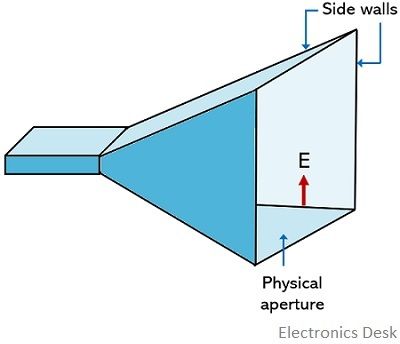Definition: Antenna apertures are used in reference to the area of the antenna. It is defined as the measure of the ability of the antenna to effectively receive the power radiated towards it.
As the term is associated with the area of the antenna, thus, shows the power capturing characteristics of receiving antennas.
The aperture in a general sense signifies a hole or slot present on a surface. Antenna aperture is the term used for the antennas that contain an opening on its surface.
Content: Antenna Aperture
Introduction
We all know that presence of an opening on a surface generally used when a certain thing must be provided as input to it through that opening, or something is required to be taken out through it. The same is the case with the antenna aperture.
We are aware that antenna units are used to transmit and receive electromagnetic waves. And so, the aperture present on the surface of the antenna allows the electromagnetic energy to get emitted through it or to receive the transmitted energy and transfer it to the load.
The aperture of the antenna is the area whose orientation is normal to the direction from where the electromagnetic wave is coming. This is done in order to intercept the equivalent power from the incoming wave as it can be produced by the antenna which is receiving it.
The figure below represents an electromagnetic horn where the incoming wave is a uniform plane wave:
We know that the aperture deals with the capturing characteristic of the antenna. So, when incident wave falls on the surface of the antenna then the falling wave induces a certain voltage on the receiving antenna. However, the amount of induced voltage shows dependency on the characteristics of the antenna.
In receiving antennas effective aperture plays a crucial role in determining the amount of voltage induced in it.
The various types of antenna apertures are as follows:
- Effective Aperture
- Scattering Aperture
- Loss Aperture
- Collecting Aperture
- Physical Aperture
Let us understand the same in detail.
Effective Aperture
When an electromagnetic wave is transmitted by the transmitting antenna then the receiving antenna present at the other end tries to capture the emitted radiation.
We have already discussed in the beginning that antenna aperture is associated with receiving antenna as it tells about the extracting ability of the antenna that is concerned with the reception of the waves.
The effective aperture of an antenna is that region of the receiving antenna that effectively collects the electromagnetic energy from the radiated wave out of the overall antenna region. This means greater the extracting region of the antenna more efficient it is.
It is defined as the ratio of power received by the antenna to the average power density of the incident wave. Thus, is given as:
: W is the received power in watts
P is the average power density in watts/m2
Ae is the effective area in m2
This means that the product of power density of the electromagnetic wave and its aperture is equal to the power received by the antenna.
So,![]()
Hence, an antenna with a larger aperture collects more power than an antenna with a smaller aperture for the same electromagnetic field. Thus, it shows usefulness in calculating the power received by an antenna.
We know that due to reciprocity theorem, the antenna gains for the receiving as well as transmitting modes are same. In a similar way, the effective aperture of the receiving antenna can be used to determine the performance of the transmitting antenna also.
Scattering Loss Apertures
Previously we have discussed effective aperture that deals with the capturing ability. However, along with this, there exist some other apertures as well.
We know that while transmission and reception of signal there exist some considerable losses also. These losses mainly correspond to the radiation and re-radiation resistances and the antenna loss resistance and this is referred as scattering aperture and loss aperture respectively.
This combinedly known as scattering and loss apertures of the antenna. Scattering aperture is denoted as As while loss aperture is denoted as Al.
Collecting Aperture
We know that out of the overall power collected by the antenna certain part is associated with the losses due to heat in load and radiation resistance along with antenna loss resistance. These constitute the three apertures of the antenna i.e., effective, scattering and loss.
Thus, the summation of the effective, scattering and loss aperture as a whole form the collecting aperture of the antenna.
Physical Aperture
Till now we have discussed the region associated with the antenna that extracts most of the radiating energy from the electromagnetic wave. However, the physical aperture of the antenna is the actual physical size possessed by the antenna. In antennas like a horn or parabolic reflector, the physical aperture is of great significance because the design of these antennas is quite large. Thus, for large physical size antennas, the physical aperture is a particular and quite important property.
The effective aperture of the antenna is designated as the unique property of any type of antenna.
It is denoted as Ap and is defined as the physical cross-sectional area of the antenna which is perpendicular to the propagating direction of an electromagnetic wave in order to have a maximum response.
It is to be noted here that in the ideal condition of the receiving antenna considering thermal losses to be null, the effective and physical aperture of the antenna is equal. This leads to providing maximum directivity of the antenna.